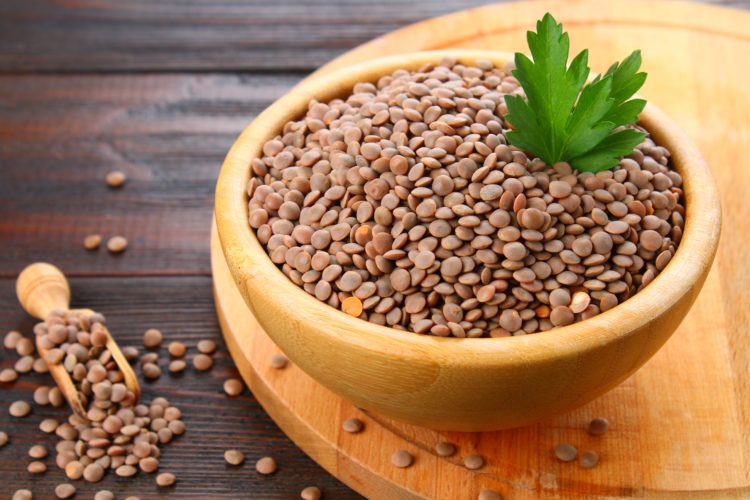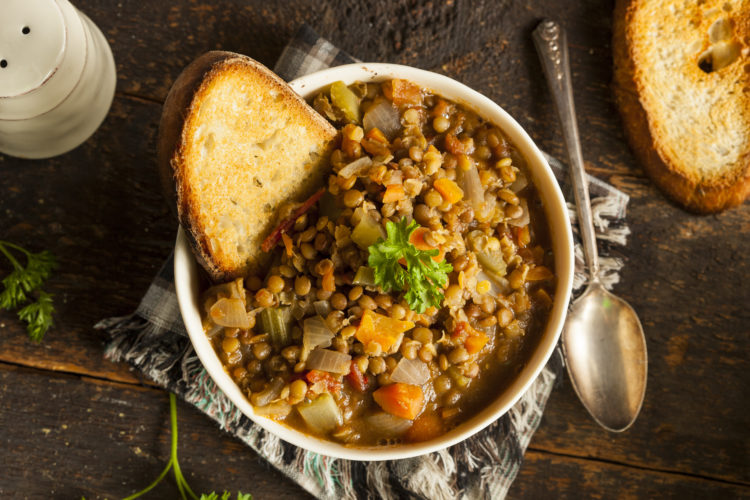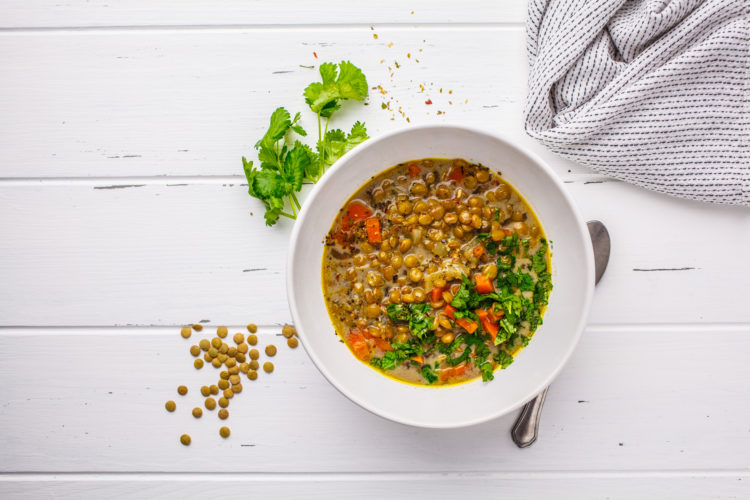It’s not the most flattering nickname, but I’ve earned the moniker “King Lentil” at the BarBend office for good reason: I eat a thousand calories of lentils and rice just about every day, and everything in my life is better because of it.
You can’t talk about eating legumes without someone immediately asking the following question, so to answer it: no, I’m not a vegetarian. I eat steak just about every night. I’m just a guy who lifts heavy and eats 3,000 calories a day, so like you (probably) I’m always looking for a way to get a good amount of protein, calories, and micronutrients without too much effort — and lentils are an absolute godsend. It’s criminal that I never hear about athletes whipping up a big ol’ lentil stew to help them get on the gains train.
I’d even argue they’re better than other legumes, like black beans and chickpeas, because they cook a lot faster, don’t need soaking prior to cooking, and they’re lower in the gas-producing carbohydrates beans are known for. Here’s a video.
5 Reasons You Should Be Eating Lentils
Here’s why you should be eating more lentils.
1. They are really high in quality protein
Because I shoot for 3,000 calories a day, I’ll eat three cups of the lentil soup I’m going to show you below. That provides 700 calories and fifty-four grams of protein. That’s a third of my daily protein intake.
Note that yes, I said quality protein. While it isn’t meat and, sure, it’s not high in every essential amino acid, lentils are very high in the branched chain amino acids that are closely linked with muscle protein synthesis.(1)(2)(3) (So are oatmeal, bread, potatoes, peas, and a lot of other plant-based foods, by the way. You really don’t have to have animal sources of protein for all your meals.) Experts agree that so long as you’re getting plenty of BCAAs and you eat a varied diet, you don’t have to have a complete protein — that’s a protein with all nine essential amino acids — at every meal.(4)(5)
2. The best poops
You will never poop better than when you’re eating a good amount of legumes. If you actually track your fiber intake, there’s a 99% chance you’re not hitting your recommended intake unless you’re eating legumes. They’re far and away the food group with the most fiber and they contain a lot of prebiotic fiber, which is really good for digestive health — it feeds the bacteria that live in your digestive tract and help you to absorb nutrients more effectively.
3. They’re insanely high in micronutrients
They’re jam-freaking packed with important nutrients. Besides the protein and fiber, my 700-calories of stew has:
- more than a day’s worth of iron — which, yes, you can get without eating meat.
- half a day’s worth of magnesium, which is really important for sleep quality, workout recovery, and managing stress. And it’s hard to get in whole foods — many athletes resort to supplements, but lentils lower your need for that.
- almost a day’s worth of zinc, which is important for maintaining healthy testosterone production. A lot of people also think zinc is only available in animal products, but it’s not the case.
- more than half a day’s worth of potassium, an electrolyte that’s important for hydration and reducing inflammation.
Lentils are really healthy.
4. They’re so cheap
Lentils are so god damn cheap. For lunch, I used to go out and spend fifteen bucks on 1,000 calories of Chipotle every day. You know what I do now? I eat 1,000 calories of lentils and rice, which costs me a dollar. I save mad money eating lentils.
5. They’re easy to make and store in bulk for future lunches
You’re only limited by the size of your pot, and remember that one serving and 20 servings takes the same amount of time to boil. They also freeze easily: what you do is buy a bunch of sandwich sized Ziplock bags, which can each store three cups of stew, fill ’em up with your bounty and toss ’em in your freezer. Eat them at some point in the next four months and you’re golden.

Lentil Stew Recipe for Athletes
For a nice big pot, here’s what you need to start with. Remember that this is a stew, which means it’s not a huge deal if the measurements vary — I always just eyeball the ingredients.
Ingredients
- 2 brown onions
- 3 big carrots
- Half a head of celery
- ¼ cup of olive oil. (Halve this if you’re worried about fat.)
- 6 cloves of garlic
- 3 tablespoons of oregano. (You can use a generic Italian herb blend here, or you can use French herbes de provence — just generic European herbs, whatever you’ve got. I think oregano should be in there, personally.)
- 2 one-pound bags of lentils
- Chicken or vegetable stock, enough for 2 liters of liquid. (You can buy liquid stock if you want, but feel free to just grab some stock cubes. It’s not a huge deal if you just use water, but stock is tastier.)
- Vinegar for garnishing. (I prefer balsamic, but any will do.)
- Optional sides: crusty bread, hard cheese, rice, spinach, an extra lug of olive oil.
Directions
- Chop up all your veggies and crush your garlic. (Or dice it if you don’t have a garlic crusher.)
- Heat the olive oil in a big pot on medium high.
- Throw in all your veggies and garlic at once with a few pinches of salt. Cook and stir until soft, it should take about 5 to 10 minutes. They’ll shrink.
- Add your herbs, stir and let that cook for a minute until they’re fragrant.
- Optional: If you want, you can throw in a can or two of crushed tomatoes at this point. You don’t have to, but it makes the whole thing smell and taste just a bit more Italian.
- Now pour in 2 liters of liquid stock or do what I do: pour in 2 liters of water and crumble in some stock cubes.
- Wait for the water to boil. (I boil my water in the kettle beforehand to help this go quicker.)
- Now pour in all your lentils. The liquid will stop boiling for a bit, but keep the heat on and once it’s boiling again, turn the heat down to low.
- Let everything simmer, stirring occasionally, for 20 to 30 minutes. Sometimes it’s done in 20, usually it’s done in 30 — it’s ready when the lentils are soft instead of chewy.
- When the lentils are good, turn off the heat. Some like to stir in a bag of spinach at this point; it’ll wilt quickly.
- Put your lentils in a bowl, garnish with a splash of vinegar, and some salt and pepper.

Lentils Nutrition Info
Here’s the nutrition info on my daily lunch.
Serving: 3 cups
Calories: 732
Protein: 54g
Carbs: 120g
Fiber: 48g
Fat: 4g
Iron: 108% RDI
Magnesium: 51% RDI
Zinc: 51% RDI
Potassium: 63% RDI
Copper: 75% RDI
Manganese: 147% RDI
Folate: 270% RDI
Vitamin B6: 54% RDI
Thiamin: 66% RDI
Phosphorus: 108% RDI
You can throw on a lug of olive oil if you want more fat, add some rice if you want more carbs, drop some chicken on top if you want some more protein. I will say that I’d recommend greasy chicken thighs instead of chicken breast, as this is already a pretty low-fat meal; adding chicken breast will give it a real dry mouthfeel.

Wrapping Up
That’s it. After 10 years of writing about health and fitness, if someone were to ask me if there is a hack for meal prep, for saving money, for diversifying protein sources, for catching up on micronutrients, this meal is my answer. It may have taken an hour to make but now you’ve got many, many days of lunches. Two pounds of dry lentils equals more than eight pounds of stew.
Stop acting like you need meat at every meal, save money, save time, get jacked, get more nutrients, and poop well with this amazing recipe.
Editor’s note: This article is an op-ed. The views expressed herein and in the video are the author’s and don’t necessarily reflect the views of BarBend. Claims, assertions, opinions, and quotes have been sourced exclusively by the author.
References
1. Zheng L, et al. Effects of Supplementation of Branched-Chain Amino Acids to Reduced-Protein Diet on Skeletal Muscle Protein Synthesis and Degradation in the Fed and Fasted States in a Piglet Model. Nutrients. 2016 Dec 28;9(1).
2. Matthews DE, et al. Observations of branched-chain amino acid administration in humans. J Nutr. 2005 Jun;135(6 Suppl):1580S-4S.
3. Blomstrand E, et al. Administration of branched-chain amino acids during sustained exercise–effects on performance and on plasma concentration of some amino acids. Eur J Appl Physiol Occup Physiol. 1991;63(2):83-8.
4. American Dietetic Association, et al. Position of the American Dietetic Association and Dietitians of Canada: Vegetarian diets. J Am Diet Assoc. 2003 Jun;103(6):748-65.
5. Millward DJ. The nutritional value of plant-based diets in relation to human amino acid and protein requirements. Proc Nutr Soc. 1999 May;58(2):249-60.